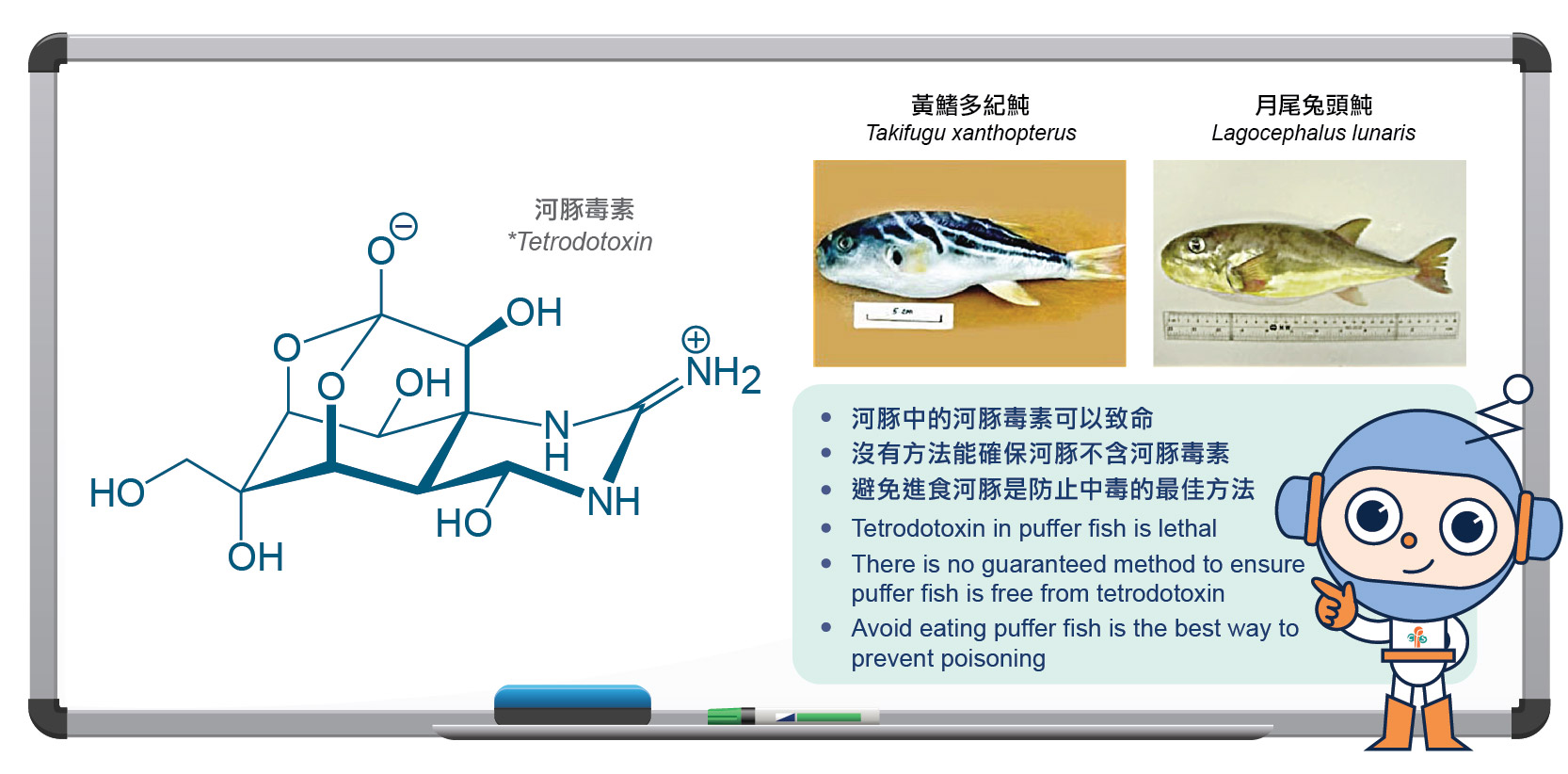
Food Safety Focus (178th Issue, May 2021) – Food Safety Platform
Tetrodotoxin – the Deadly Poison in Puffer Fish
Reported by Dr. John LUM, Scientific Officer,
Risk Assessment Section, Centre for Food Safety
In April 2021, the Centre for Health Protection of the Department of Health investigated a suspected puffer fish poisoning case that involved a 28-year-old man who developed dizziness and palpitation shortly after consuming puffer fish at a restaurant. So, what makes the puffer fish poisonous?
Tetrodotoxin in Puffer Fish
Many puffer fish of the family Tetraodontidae possess a highly potent toxin known as tetrodotoxin (TTX), which is over 1,000 times more toxic to humans than cyanide according to some authorities and literature. TTX can bind to the voltage-gated sodium channels in nerve cell membranes. This interferes with the transmission of signals from nerves to muscles, causing paralysis of the body’s muscles.
In general, TTX is more concentrated in the gonads (mainly ovary), liver, intestines and skin of puffer fish. However, certain species of puffer fish also contain TTX in their flesh. The level of TTX among puffer fish varies across geographical regions, species and seasons. TTX is heat-stable and cannot be destroyed by cooking, freezing or drying.
Origin of TTX in Puffer Fish
Although the source of TTX in puffer fish has not yet been conclusively identified, it is believed that puffer fish acquire TTX in their diet. The toxin then rapidly accumulates and is distributed to various tissues of the fish. TTX has been found to be produced by several bacterial species, with Vibrio alginolyticus being the most common species. Some of these bacteria are colonised in the intestines of puffer fish.
Presentation of TTX Poisoning
All humans are susceptible to TTX poisoning. Initial symptoms start within 20 minutes to two hours after intoxication, which include numbness of the lips and mouth, followed by tingling in the extremities, slurring of speech, motor imbalance, muscle weakness and paralysis. In severe intoxication, death can be resulted from respiratory and/or heart failure. The victim, although completely paralysed, may be conscious and completely lucid until shortly before death. There is no antidote for TTX poisoning.

Figure 2: Tetrodotoxin in puffer fish (Photo courtesy of the Agriculture, Fisheries and Conservation Department)
Myths and Facts of Puffer Fish
Since TTX concentrates in the internal organs and skin of puffer fish, is it safe if I only eat the flesh?
Although TTX accumulates mainly in the viscera and skin of puffer fish, some species of puffer fish are known to contain a high level of TTX naturally in their flesh. Moreover, the flesh of puffer fish is extremely easy to be contaminated by TTX in other tissues during dressing and other preparation. Removal of toxic organs from a puffer fish without contaminating the flesh depends on the skills of the handlers and the accreditation system to ensure the handlers meet the requirements. At present, there is no internationally accepted guideline, procedure and accreditation scheme for the preparation of puffer fish to prevent TTX contamination.
Is farmed puffer fish guaranteed free from TTX?
The exact mechanism of TTX production, distribution and accumulation in puffer fish is not fully understood. Although there is literature reporting that puffer fish artificially reared with non-toxic diets possess a lower TTX amount, TTX is still present in various tissues (e.g. ovary and liver) of farmed puffer fish. The Food Safety Commission (FSC) of Japan has evaluated the toxicity and the aquaculture method of farmed puffer fish. The FSC concluded that the mechanism of toxin production in puffer fish is still unknown, and conditions for farming puffer fish to reduce the toxin level have not been officially established. As such, it cannot be guaranteed that farmed puffer fish is free from TTX.
Can we ensure the safety of puffer fish through sampling and testing scheme?
According to the US Food and Drug Administration, there is no adequate sampling scheme to ensure a safe lot of puffer fish since any single fish may contain a lethal dose of TTX. In other words, the absence of TTX in a fish sample cannot guarantee other fish are toxin free. While there is no antidote for TTX, the stake of eating puffer fish remains extremely high, even with a sampling and testing scheme in operation.
Key points to note
- Puffer fish contain tetrodotoxin, which is lethal.
-
Tetrodotoxin cannot be destroyed by cooking, freezing or drying, and there is no antidote to it.
-
Not to consume puffer fish is the only reliable way to prevent tetrodotoxin poisoning.
Advice to the Trade
Not to import or sell puffer fish as food.
Advice to the Public
Not to consume any part of puffer fish and processed puffer fish.


